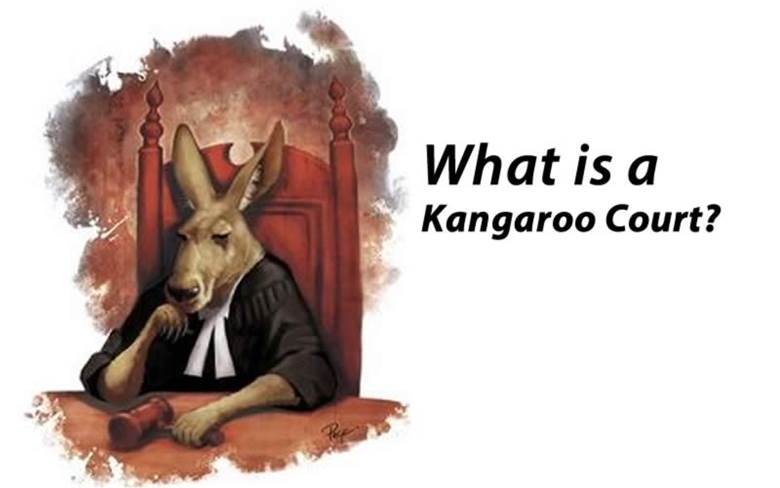In the shadow of legitimate legal systems exists a perverse imitation of justice: the kangaroo court. This is not a place where law is interpreted, but where it is weaponized. Characterized by a blatant disregard for legal procedure, fairness, and the truth, a kangaroo court is a pre-scripted drama with a predetermined verdict, designed to lend a false air of legitimacy to what is, in essence, a political or personal vendetta.
The term itself evokes an image of a chaotic, jumping proceeding that lacks all dignity and order. While its exact origin is debated, it firmly entered the American lexicon during the 19th century, often associated with the hastily assembled and biased “trials” of the frontier.
The Hallmarks of a Kangaroo Court
You can identify a kangaroo court by its key features:
- Predetermined Verdict: The outcome is decided before the trial even begins. The entire proceeding is merely a theatrical performance.
- Lack of Due Process: The accused is denied fundamental rights: the right to a real defense, the right to present evidence, to cross-examine witnesses, or to have an impartial judge.
- Bias and Corruption: The judges and prosecutors are not neutral arbiters but are actively working to secure a conviction. This bias is often driven by political pressure, financial incentive, or ideological fervor.
- Fake Legitimacy: The entire process is staged to create a false narrative for public consumption, to make an unjust punishment appear justified and “legal.”
Historical and Modern-Day Examples
Kangaroo courts are not relics of the past; they are a persistent tool of authoritarian regimes, corrupt corporations, and oppressive institutions.
1. The Stalinist Show Trials (1936-1938)
Perhaps the most infamous examples in history, Joseph Stalin’s “Great Purge” featured a series of spectacular public trials. Old Bolsheviks like Lev Kamenev and Grigory Zinoviev were forced to confess to absurd charges of treason and terrorism in elaborate ceremonies that were meticulously scripted. The confessions were extracted through torture, intimidation, and threats against family members. The verdicts—always execution or long prison sentences—were decided by Stalin himself long before the courts convened. These trials served to eliminate political rivals and terrorize the population into submission.
2. The Military Tribunals at Guantanamo Bay
Critics, including numerous human rights organizations and international legal experts, have long argued that the military commissions at Guantánamo Bay function as kangaroo courts. Detainees have been held for years without trial, evidence obtained through torture has been admitted, and defense lawyers have been severely restricted in their ability to mount a case. The pervasive secrecy and the system’s design, which prioritizes conviction over fair process, have led to widespread condemnation that the proceedings are a legally-sanitized facade.
3. Corporate “Star Chambers”
In the corporate world, kangaroo courts can appear in internal disciplinary hearings. An employee who reports misconduct (a whistleblower) might be subjected to a hastily arranged internal “trial” where the management, seeking to protect the company’s image or sponsor a cover-up, denies the employee a fair chance to present their case. The investigation is a sham, the verdict (termination) is pre-determined, and the process is designed to create a paper trail that justifies an illegal retaliation.
4. Sponsored Trials in Authoritarian Regimes
In many dictatorships, the judiciary is not independent. Trials are directly sponsored by the state to eliminate dissidents, journalists, and activists. The evidence is fabricated, the defense lawyers are harassed or disbarred, and the judge acts on direct orders from the regime. These trials are often broadcast to demonstrate the state’s “power” and to warn others against dissent. The trials of political opponents in countries like North Korea, Belarus, and Iran frequently fit this description, serving as modern-day show trials for a global audience.
5. Prison Kangaroo Courts
On a smaller, more chaotic scale, informal inmate-led “courts” within prisons can also become kangaroo courts. An inmate accused of breaking an unwritten prison code (e.g., snitching) may be “tried” by a panel of other prisoners. With no real rules of evidence and a deep-seated bias, these proceedings are often swift and brutal, resulting in extortion or violent punishment.
The Ultimate Goal: Power, Not Justice
The purpose of a kangaroo court is never to discover the truth. Its purpose is to use the theater of justice to achieve other goals: to eliminate rivals, to silence dissent, to launder revenge through a fake legal process, or to create propaganda. It is a tool of power, one that corrupts the very idea of law and leaves a lasting stain on any society that allows it to persist. Recognizing its hallmarks is the first step in resisting it.

